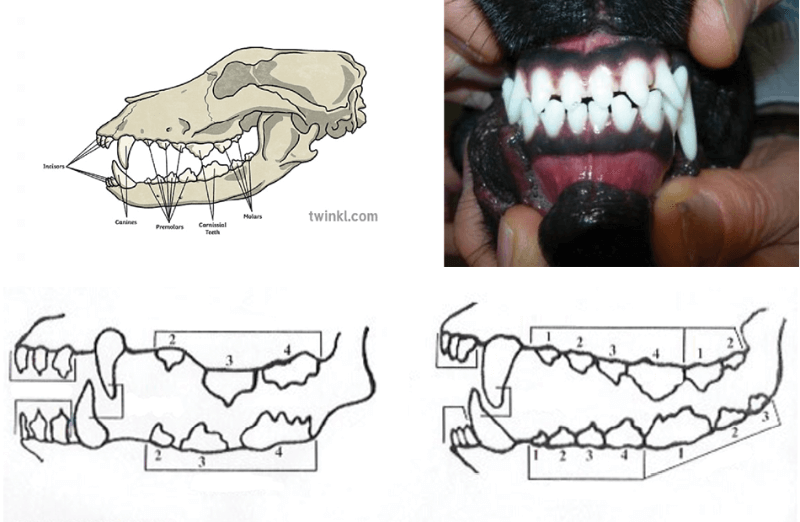The Importance of Examining the Rottweiler’s Bite & Dentition
The Disqualifications listed in the AKC Rottweiler Breed Standard include:
- Entropion, ectropion.
- Overshot, undershot (when incisors do not touch or mesh); wry mouth; two or more missing teeth.
- Unilateral cryptorchid or cryptorchid males
- Long coat.
- Any base color other than black; absence of all markings.
- A dog that in the opinion of the judge attacks any person in the ring.
Most of these disqualifications are easy to determine during an exam in the show ring, but one of these takes a bit more time, skill, and knowledge of canine dentition and how to count teeth. I have seen a few judges just do a quick and cursory look at the bite and mouth, and move on to the rest of the dog. That will not determine if the dog has two or more missing teeth. Overshot and undershot bites are also a DQ. Serious faults include a level bite and one missing tooth. I am hoping to be able to describe how to examine the Rottweiler’s mouth, to do it efficiently, and to know where missing teeth are most often found.
Rottweiler Dentition
Adults should have 42 teeth, but remember when looking at puppies, they only have 26: 6 incisors, 2 canines, and 6 premolars (P2, P3, P4) on both top and bottom. They do not have a P1, nor do they have any molars. Puppy teeth should all be in by 8 weeks, and permanent, adult teeth should all be present by 8 months. Below are diagrams of both a puppy’s and a dog’s dentition, as well as instructions for counting teeth in groups.

Counting Teeth in Groups
- Look for 6 incisors and 2 canines, both upper and lower. This can easily be done when checking the occlusion (bite).
- Look for 4 premolars and 3 molars on each lower side, and 4 premolars and 2 molars on each upper side.

The Rottweiler has a scissors bite. On occasion, Rottweilers can be missing an incisor (the front teeth). Usually it is only one, and often only on the top or bottom. Make sure, as you see above, the seams between the teeth line up. If a tooth goes on top of a seam, most often one of the incisors is missing and this means taking a second look. Remember, level bites are a serious fault, and overshot and undershot are disqualifications.

The side bite has four premolars. These are right behind the canine teeth. Most often, a P1 is one of the most common missing teeth. Note how small they can be, so it is important to ask the exhibitor to show these and not put their fingers in the way. Behind the three premolars, are the regular, larger molars.

This illustration shows a complete view of the side dentition; three premolars on both sides, three larger molars on both sides. However, the bottom jaw has an extra molar, called the M3 or sometimes referred to as the “popcorn” molar. This M3 is another common missing tooth and takes some effort to see and determine whether it is missing or not. I have the exhibitor open the dog’s mouth, and an experienced handler will also stretch the back lips to give a better view. If they do not, ask them. You need the see the M3s in the very lower back. Specify which tooth you can’t see, and most exhibitors will help for you to see those teeth.
It is important when examining a Rottweiler to avoid direct eye contact. I do this with all breeds I judge, as for some dogs it is a confrontational and threatening gesture. I always ask the exhibitor to show the bite first. The Rottweiler is an aloof breed, and generally will only tolerate so much examination. I do the bite first while the tolerance level is highest. They don’t get better if done at the end, and often dance around more at that point. I don’t care if the dog is standing or sitting, if I have a good view to see the bite and dentition. It is important in my breed that the judge does the entire examination at once (examine bite, look overhead for proportion, and then check testicles and tail.
Once I remove my hands from the dog, I am finished and do not return. I want the examination to be a win-win for both the dog and the judge. There is no reason to linger over them. Movement will show soundness and any structural issues. I move them twice around the ring when they enter and again at the end in large classes. Once I have found the best-moving dogs, I pick the ones that have the best breed type for my placements. And no, I don’t go back and touch them again (e.g., shoulders, loin, head, etc.).
It is my goal to make sure all judges understand the dentition of the Rottweiler and take the time to look at the bite and be able to count teeth in the groups I’ve outlined above; that would be to count the front teeth or incisors (six top and bottom), to find the four premolars on each side (knowing that the P1 is the most common missing tooth, although it can happen with any of them), and to check for the M3 (small molar farthest back on the bottom jaw). I ask the exhibitor to show me the front teeth, then one side, then the other, and then open the mouth to view the M3s.
The Rottweiler was one of my first breeds (45 years ago), so while examing the bite and dentition may seem easy to me, I understand the difficulty for those coming from breeds that don’t count teeth. However, this is VERY IMPORTANT to understand and learn for judging this breed.
I hope everyone found this to be clear, but if you are still confused or have questions, please contact me. I am happy to help.
Rottweiler Breed Magazine
Showsight Magazine is the only publication to offer dedicated Digital Breed Magazines for ALL recognized AKC Breeds.
Read and learn more about the Rottweiler dog breed with articles and information in our Rottweiler Breed Magazine.
Error embedding FlippingBook shortcode, please check the flipbook url. (https://digital.showsightmagazine.com/view/55801/)













